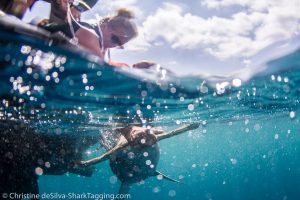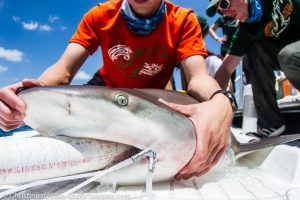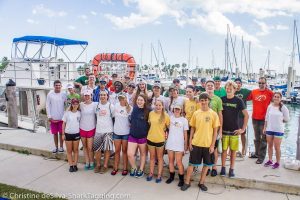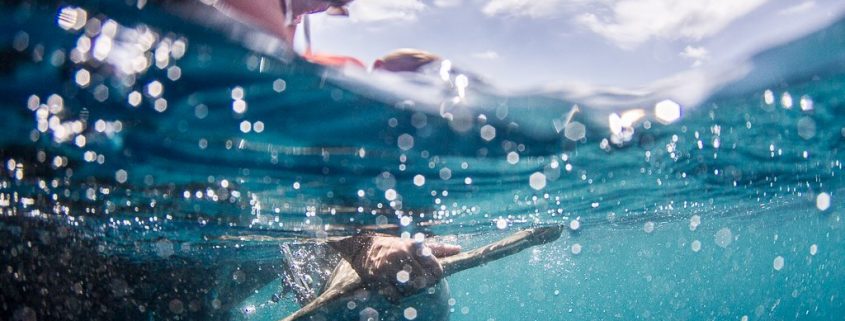Shark tagging with St. Thomas Aquinas
By Grace Roskar, SRC Intern
The morning of April 23rd, 2016 felt like a summer day with its warmth and sunshine. St. Thomas Aquinas High School from Fort Lauderdale, Florida, and Dalton Hesley of UM’s Rescue a Reef Program joined the SRC team for a day of shark tagging. The group of young marine biology enthusiasts and our citizen scientist Dalton met the SRC team at Crandon Marina at 8 am to load the boat and get underway.
As we motored out to “Sandbar Palace,” a tagging site off of Miami Beach, trip leader and SRC graduate student Jake explained what a day of shark tagging would be like and the importance of shark research and conservation. Meanwhile, the SRC prepared drumlines with barracuda for bait. Extensions lines were also attached to the drumlines, as Sandbar Palace was considered an offshore site and the drumlines were deployed in 80-100 feet of water. The St. Thomas Aquinas students helped deploy the first set of ten drumlines and while they were soaking for an hour, Captain Nick motored the boat to a spot for swimming. Students and SRC members alike took a refreshing dip in the cool waters as a respite from the heat of the day. Once the swim break was over, we motored back to Sandbar Palace to pick up the drumlines in hopes there would be some sharks on them!
On line number 1, there was a scalloped hammerhead! This species, Sphyrna lewini, is classified as endangered on the International Union for Conservation of Nature’s (IUCN) Red List of Threatened Species , and the Central & Southwest Atlantic population is listed as threatened under the Endangered Species Act (ESA) . Thus, it is rare for SRC to see scalloped hammerheads, so it was quite the lucky catch! Due to the status of scalloped hammerheads and their tendency to become stressed more easily than other species, the SRC team performed an in-water workup of the male shark as quickly as possible to ensure a safe and expedient release of the shark. The 2.37 meter shark received a tag, and was released in a timely manner. The excitement onboard was palpable, coming from both the students and the SRC crew. The team was feeling extremely grateful to be able to sample such an incredible species, and most of the students were able to lay their eyes upon a hammerhead species for the first time.

A scalloped hammerhead is carefully secured in the water for a quick workup process
To everyone’s surprise, line 4 had another scalloped hammerhead! The SRC team repeated the same in-water workup process in order to safely sample the 2.5 meter shark. We felt extremely grateful to have been able to sample not one, but two of these graceful apex predators while still on the first set of drumlines. Line 6 offered us another surprise- this time an octopus! As we pulled in the line, we noticed an octopus had suctioned itself onto the piece of barracuda bait. SRC intern Shannon carefully placed the octopus into a bucket of seawater to utilize the learning opportunity for the students. Shannon quickly explained their feeding mechanisms, basic anatomy, and other interesting cephalopod facts while the students peered into the bucket to examine the beautiful creature for a few minutes before it was safely placed back into the ocean.
St. Thomas Aquinas students helped pull in the rest of the set of the drumlines, and on line 10 was a great hammerhead! The great hammerhead (Sphyrna mokarran) is also classified as endangered on the IUCN Red List[1] and we were grateful to see our second hammerhead species of the day. Again, an in-water workup was performed by the SRC team to ensure the quickest release possible for the biggest hammerhead of the day: 2.66 meters, or about 8.7 feet. We motored back to line 1 to pick up the second set of drumlines and picked up a sandbar shark (Squalus plumbeus), our third species of the day! The SRC team carefully brought the shark onto the platform at the stern of the boat and the St. Thomas Aquinas students finally had the chance to help work up a shark. The students helped test the shark’s nictitating membrane to test the shark’s stress levels, took several length measurements, took a sample of the dorsal fin, and inserted a tag into the shark’s dorsal fin. Several other morphological measurements and a blood sample were taken from the shark before it was safely released.

SRC Masters student Jake secures a sandbar shark while a water pump is placed in its mouth to flush oxygenated seawater over the gills. This helps keep the sharks calm and healthy during the quick workup process
Next on the line, a nurse shark was pulled up, one of the most common species that SRC is able to sample around the waters of Miami. This 2.32 meter nurse shark was also worked up by a team of St. Thomas Aquina students and the SRC team. After a quick workup, students were able to take a few moments to touch the shark and feel its dermal denticles, which are scales that are basically modified teeth, as dermal denticles means “small skin teeth.” Nurse shark dermal denticles are coarser than other shark species’ dermal denticles and look like a mosaic of a variety of brown and gray shades. On the same set of drumlines, three more sandbar sharks were pulled up and sampled.

Thanks St. Thomas Aquinas and Dalton for coming out with us for an amazing day of shark tagging!
On the third set of drumlines, yet another sandbar and scalloped hammerhead were pulled up – making it the third scalloped hammerhead of the day. The entire SRC team was in awe that we were so lucky to see three individuals of this rare and beautiful species, in just one day! The SRC crew members that have been with the program for a substantial amount of time concluded that this was indeed a rare sight and estimated that the program has probably caught less than ten scalloped hammerheads in its entire existence—which made our three for the day an even more incredible statistic. After ten sharks of four different species on thirty lines, the team and high school group was elated and grateful for such a spectacular day of shark tagging. Although it was a hot summer-like day, the high school students’ spirits remained high throughout the day and the SRC team was honored to have such enthusiastic guests helping us out on the boat for the day. We look forward to having St. Thomas Aquinas back out with the Shark Research and Conservation Program again soon!




Leave a Reply
Want to join the discussion?Feel free to contribute!